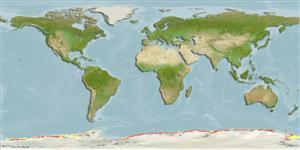>
Perciformes/Notothenioidei (Icefishes) >
Nototheniidae (Cod icefishes) > Trematominae
Etymology: Trematomus: Greek, trematos = hole + Greek, tomo = section, cut (Ref. 45335); nicolai: Named after Nicolai Hanson, biologist and collector of Southern Cross fishes, died at Cape Adare during the expedition (Ref. 11892).
Eponymy: Nicolai Hanson (1870–1899) was a Norwegian zoologist and Antarctic explorer. (See Hanson) (Ref. 128868), visit book page.
More on author: Boulenger.
Issue
The genus Pseudotrematomus is a synonym of Trematomus, which is confirmed by a molecular study to be published (J.-C. Hureau, pers. comm. 08 Jun. 2010).
Environment: milieu / climate zone / depth range / distribution range
Ecologia
marinhas demersal; intervalo de profundidade 1 - 420 m (Ref. 11892). Polar; 65°S - 78°S
Southern Ocean: East Antarctica (some localities), but not from the Peninsula region and westward to the Ross Sea. Coasts of Adelie Land, Davis, Weddell, South Shetland and South Orkney Islands.
Tamanho / Peso / Idade
Maturity: Lm ? range ? - ? cm
Max length : 36.0 cm TL macho/indeterminado; (Ref. 5179); peso máx. Publicado: 0.00 g
Espinhos dorsais (total) : 4 - 5; Raios anais moles: 31 - 35. Body brownish, more or less distinct dark crossbars, scattered small dark spots, fins dusky, spiny dorsal blackish (Ref. 11892).
A nearshore benthic species usually abundant in shelf waters of East Antartica (Ref. 122792). Adults feed primarily on amphipods, other fishes, and molluscan larvae, with lesser amount of polychaetes and mysids. They capture some prey in the water column, but are not cryopelagic.
Dewitt, H.H., P.C. Heemstra and O. Gon, 1990. Nototheniidae. p. 279-331. In O. Gon and P.C. Heemstra (eds.) Fishes of the Southern Ocean. J.L.B. Smith Institute of Ichthyology, Grahamstown, South Africa. (Ref. 5179)
Categoria na Lista Vermelha da IUCN (Ref. 130435: Version 2024-1)
Ameaça para o homem
Harmless
Utilização humana
Pescarias: sem interesse
Ferramentas
Relatórios especiais
Descarregue XML
Fontes da internet
Estimates based on models
Preferred temperature (Ref.
123201): -1.8 - -0.4, mean -1.4 °C (based on 382 cells).
Phylogenetic diversity index (Ref.
82804): PD
50 = 0.5005 [Uniqueness, from 0.5 = low to 2.0 = high].
Bayesian length-weight: a=0.00631 (0.00422 - 0.00943), b=3.21 (3.09 - 3.33), in cm total length, based on LWR estimates for this species & Genus-body shape (Ref.
93245).
Nível Trófico (Ref.
69278): 3.6 ±0.53 se; based on food items.
Generation time: 13.7 ( na - na) years. Estimated as median ln(3)/K based on 2
growth studies.
Resiliência (Ref.
120179): Médio, tempo mínimo de duplicação da população 1,4 - 4,4 anos (Fec = 8,900).
Fishing Vulnerability (Ref.
59153): Moderate to high vulnerability (51 of 100).
